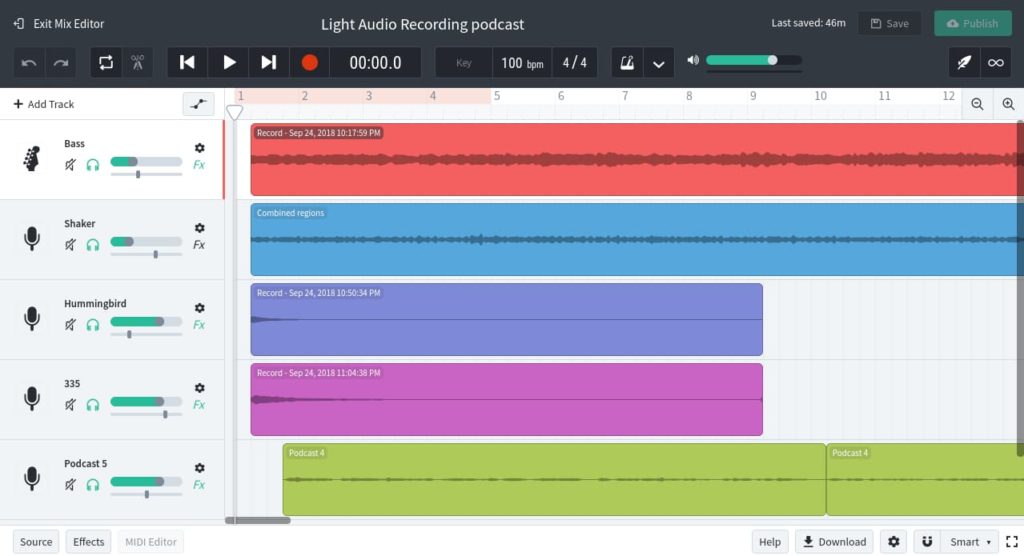NAMM is done for 2019. In episode 5 of the light audio recording podcast, we look at some of the cool stuff that came out of it. Certainly, it focuses on compact and affordable recording.
Episode 5
Here’s an MP3 of episode 5.
Transcript
Introduction
Hi light audio recordists!
This is Ronan Fitzgerald from light audio recording dot com. It’s Thursday January thirty first, twenty nineteen. Can you believe tomorrow is February?
Anyway, it’s time for episode five of the light audio recording podcast. As you can probably guess, we’re fresh from all the excitement of NAMM.
So, if you couldn’t guess, that’s what this month’s podcast is focused on. Where, from out of all the expensive stuff, we’ve pulled the items focused on keeping your music production cheap and cheerful.
For some reason, the most cost-efficient stuff was aimed at guitarists.
Item one
BandLab’s big NAMM news was their Creator Connect function of their platform.
One of the best reasons for recording music on the internet is the ease in collaboration, and Creator Connect looks set to make it even easier.
It’s free to use, currently available on iOS, and will be rolled out to other platforms over the next while.
From BandLab’s blog, it works like a dating app. And let’sl face it, whether you’re looking for a date or a bandmate, it’s all about looking for love.
With Creator Connect, you complete your profile, it suggests collaborators based on that, and you swipe through them for the right one.
This could be helpful in light audio recording. For example, if you need real drums for your track, but don’t have access to a kit or drummer, you can jump on BandLab’s Creator Connect to see if anybody can put some down for you.
Item two
One of the most favorable guitar brands for light audio recording is Epiphone, and there was great excitement about their return to NAMM this year.
Amidst a slew of signature models for Slash, Joe Bonamassa, and Peter Frampton, there was a return of a familiar model from the old school, in the form of the DC Pro.
DC stands for double cut, and it’s revival of a model that came out in the seventies. Apart from a choice of five pretty awesome finishes, this is your classic slab of mahogany with a couple of humbuckers stuck in it.
It also comes loaded with Grover tuners, and those aforementioned humbuckers are coiltapped if you need it to sound a bit brighter.
The full specs are on Epiphones website. No price available just yet, but as a solid body Epi, it should be within budget for light audio recording.
Item three
Saving space is one of the most important things in light audio recording, so keeping your amp sounds in small boxes is a helpful approach.
For guitar-oriented light audio recording enthusiasts of a certain age, Green Day’s Dookie is a very important album.
The guitar sound on that album was created with two Marshall Plexi nineteen fifty nine SLP amps. The blend of both amps were adjusted depending on the song.
To celebrate the album’s twenty fifth anniversary, MXR put both amps into a pedal. There’s a blend knob for you to do what you want with them.
The little box comes priced at around one hundred and ninety dollars. It’s currently available for preorder. But I can’t seem to find an actual release date for it.
In summary, I can see this appealing to light audio recorders looking for that classic mid-nineties pop punk sound, while saving space.
Item four
And finally, in the pro audio section, there doesn’t seem to have been many products that align with light audio recording’s compact and affordable ethos.
However, Native Instruments, probably best known for their software efforts, revealed a couple of diddly audio interfaces, that will take up almost no room.
They’re called the Komplete Audio One, and Komplete Audio Two, and that’s Komplete with a kay.
The main differences between them are the inputs. The Komplete Audio One has a single XLR input for a mic, and a single jack plug input for a guitar or other instrument.
The Komplete Audio Two has two combined XLR jack plug inputs, giving it a little bit more flexibility.
In terms of light audio recording, the two is probably the better option: we’re trying to keep space to a minimum, so the more that space does, the better!
Both are released in March, with the One costing one hundred and nine dollars, and the Two costing one hundred and thirty nine dollars.
Wrap up
That is all for this month. However, you’ll get to hear my charming Irish accent in a month or so, with the next episode of the light audio recording podcast.
If you haven’t already, please subscribe to the light audio recording blog at light audio recording dot com, where you can follow my exploration of recording music in an affordable and compact way.
You can also find light audio recording on Instagram, Twitter, and Facebook.
To conclude, I’m Ronan Fitzgerald, you’ve been listening to episode five. Have a great weekend recording your music, and I’ll catch you next time.
Production
Episode 5 used an identical setup to episode 4, namely…
- ASUS Chromebook Flip C100PA
- Samson Studio GT monitors
- Beyerdynamic DT-100 headphones
- Shure 55SH Series II
- Pig Hog XLR cable
All of these were used with BandLab to bring the podcast together.

If you found this helpful, subscribe on the right hand side of this page. You’ll be notified of new posts on Thursdays, inspiring you going into the weekend.
Share your own light audio recording thoughts and experiences! There’s a Facebook group, a Subreddit, Twitter and Instagram.
Also, feel free to shoot me a coffee!